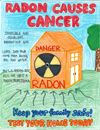Radon in Schools
Translate this page into other languages:
English
Español
中文
繁體中文
Русский
יידיש
বাংলা
한국어
Kreyòl Ayisyen
Italiano
العربية
Polski
Français
اردو

- This information is available in PDF in English.
Radon is a naturally occurring, colorless, odorless, radioactive gas that can get into any type of building, including school buildings.
Radon Testing
Radon levels may be highly variable from one building to the next. Radon testing is strongly encouraged, inexpensive, and easy. It is the only way to know if your school has high levels of radon.
- Test every five years, or two years with a mitigation system in place.
- Test during the winter months when levels tend to be higher. Remediate when levels are 4 picocuries/liter (pCi/L) or more. Consider remediating for radon levels between 2 pCi/L and 4 pCi/L.
- Take preventive design and construction measures if a school is constructed in an area with 11% or more of homes with radon estimates above 4 pCi/L.
- It is the school district's responsibility to be aware of the geological potential for high levels of radon and to test and mitigate as appropriate. Visit the New York State Department of Health Radon Monitoring Program to see state and county maps of short-term basement and long-term living area radon measurements.
Radon Entrance Points
- Cracks in solid floors and walls
- Cavities inside walls
- Construction joints
- Exposed soil, as in a sump
- Cracks between poured concrete (slab) and blocks
- Loose fitting pipes
- Water supply
Health Effects of Radon
- Radon is the leading cause of lung cancer among non-smokers
- Lung cancer risk in children may be almost twice as high as in adults
More Information

Annual Radon Poster Contest
At the beginning of each school year, New York State Department of Health sponsors a radon poster contest for students to learn about the harmful effects of radon and why people should test their homes for radon. Learn about how students can participate in the 2024-2025 contest.
Infographics
Additional Resources
- Long-term living area estimates for towns and cities. Map showing indoor radon by county.
- Basement short-term estimates for towns and cities. Map showing indoor radon by county.
- Radon in Schools. Information from the US Environmental Protection Agency (EPA) website pertaining to exposure, testing, and reduction of radon in schools.
- New York State Radon Poster Contest. A state-wide contest through the NYSDOH for children 9-14 enrolled in public, private, or home school—or through a sponsoring club or organization.
- Radon Information. Resources from the NYSDOH on Radon and Radon testing.
- Protect Your Family From Radon: A Guide for New York State Residents. Information compiled by the NYSDOH on the effects of radon, high-risk counties in New York State, ordering a radon test kit, and installing a radon reduction system.
- New York State Department of Health Radon Monitoring Program. Information on how to obtain a radon test kit, find certified mitigation professionals, and check if your area may have high levels of radon.